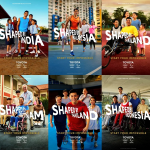By Mark Tungate
Advertising has always had a Proustian power of transportation. To see an ad from your childhood is to be instantly whisked back there. Many ads that those of a certain age cherish were made by the French production company LA\PAC. And they’re not just French.
Remember why 1984 wasn’t like “1984”? Ridley Scott’s masterpiece for the launch of the Apple Mac was born right here.

LA\PAC was founded in 1972 by Thierry de Ganay and Daisy de Galard (who left shortly afterwards) and taken to even greater heights from 1980 by Alain Benard, who remains at the helm today. More recently, in 2015, he was joined by current CEO Jérôme Denis.
The book – which is art directed by the legendary Peter Knapp, still full of energy at 91 years old – does not just focus on the past. Plenty of the films in its later pages will be familiar to millennials too. Jérôme tells us how it all came together.
Why did you choose a book to celebrate 50 years of LA\PAC, rather than, say, a documentary film?
(Laughs) That is THE question, isn’t it? Very early on, we saw the 50th anniversary approaching and said to ourselves that we had to do something. We thought – a party? But then we thought, “It’s kind of a shame to have all that material, all those films we’ve made over the years, and not do anything with them.” So why a book? First of all, I have a taste for books and literature…Plus we wanted something permanent, something you could hold. We felt that a documentary would have been too complex in terms of contacting everyone, the film rights and so on. A book seemed more accessible.
How long did it take?
We started working on it in July last year and thought it would be ready for January. In fact it’s just coming out right now, almost a year later! It was a full time job: here at LA\PAC it was overseen by Tatiana Matillat, who devoted her entire time to it: recovering the archives, contacting agencies, getting permissions, collaborating on the design…it was a titanic job. Alain [Benard] also got heavily involved.
It was very touching for him. For example, when he called [director] Jean-Paul Goude, they spent three hours on the phone together. For Alain it went beyond a book and turned into a wonderful human experience.
Art directed by Peter Knapp, the book is visually stunning. How did you convince Peter to get involved?
He has directed films for LA\PAC, but above all it’s a family story. Peter was the second husband of Alain’s first wife. He raised Alain’s children over there in Switzerland. What happened was, when we started collecting material for the book, we quickly realized that we had a giant on our hands. So we needed an art director. Alain said, “I’ll call Peter.” And Peter agreed – but he said, “Only if we do something really good.
We’re going to take our time and do it properly.” At 90 years old he’s still full of curiosity and rigour. But I think it was also a pleasant experience for him, to plunge into the past like that.

What was your process when deciding what to include in the book and what to leave out?
The first and most difficult job was to gather as much material as we could. In the end we recovered almost all the films from 1977 to today. After that, it became a little tricky because there were diplomatic issues: “If we have Danone we have to have L’Oreal,” and so on. My other fear was that the weight of the past would crush the present.
How would today’s films compete with monuments like Chanel’s “Égoïste” and Apple’s “1984”? In the end Peter came to the rescue. He asked us to give him a free hand, so he could choose the images based on his artistic and iconographic vision. He went through the mountain of material, made his selection and drew the entire layout himself, by hand.
Looking through the book, what films stand out for you as summing up the spirit of LA\PAC and your time there?
I’m a relative newcomer – I’ll have been here seven years in October – and one of the things I was most relieved about when I saw Peter’s layout was that the more recent films stood their ground visually, in terms of power and presence, with those of the past.
For example the film for Leroy Merlin [“Life’s Adventure], directed by Reynald Gresset, which was one of my first here and represents advertising at its best: strong conceptually, visually and in craft.

Then there are our films for Yves Saint Laurent, with Nathalie Canguilhem, which symbolize luxury and LA\PAC’s long and constant involvement in that world. They also represent a new way of working: today there’s no agency, we work directly with Saint Laurent. That has changed the advertising equation.
Equally I’d mention the director Quentin Deronzier and his work for Nike. We discovered him on Instagram and signed him. He was making short 3D films for himself.
One day he posted a film and went walking in the mountains around Annecy, where he lives. When he came back his Instagram account had exploded – he went from 10,000 followers to 100,000 with one film…We signed him two and a half years ago and he’s been working ever since, always directly with the client.
This is really the latest step: Instagram magnifies and resonates personal work, and the end result is a young talent making films directly with the client.
For me, those three campaigns represent the evolution of the industry, which is of course the subtext of the book.
How do you think film is faring in a world dominated by digital and social media? It seems to have held on to its prestige.
I agree with you, but it’s important to question that notion of “prestige”. Is it because film is still relevant, or is it due to an affection for the past?
From a French perspective, I think we’re in a difficult period. Plenty of films are being made, but if festivals like Cannes are representative of quality, then France is less visible right now.

It’s partly a problem of smaller budgets. Also a lack of exposure internationally, as juries tend to react positively to films they’ve seen before, especially when they’re viewing 20 hours of work. Additionally, France is extremely implicated – like LA\PAC itself – in the luxury business. And those films are rarely represented at awards shows, or misunderstood when they are.
Luxury is a 90 per cent French industry and an international jury doesn’t have a taste for it. Most of them have no experience of it. So I think we need to be a little more active with our creative colleagues around the world in terms of explaining and promoting our work.
This is an unfair question but: how do you see advertising films evolving over the next fifty years?
You know, one thing I’ve learned from this book – and from working with Alain, who is somewhat older than me – is that over the past 50 years, nothing much has changed. Perhaps the way we make films has changed, since the arrival of digital, of mobile phones and so on; but the end result is the same. A film is a film.
So in 50 years I can envisage a LA\PAC in buoyant health, with a new generation learning from the generation I’m nurturing today, just as I’ve learned from Alain. With the same curiosity, professionalism and rigour, the same admiration for directors. And above all, the same love of film.
MARKETING Magazine is not responsible for the content of external sites.







![FRED & FARID Launches [Ai]magination, a Global AI Production Studio Tailor-Made for Brands, CMOs and Agencies in 2024. ezgif-1-54eb746051](https://marketingmagazine.com.my/wp-content/uploads/2024/01/ezgif-1-54eb746051-150x150.jpg)


